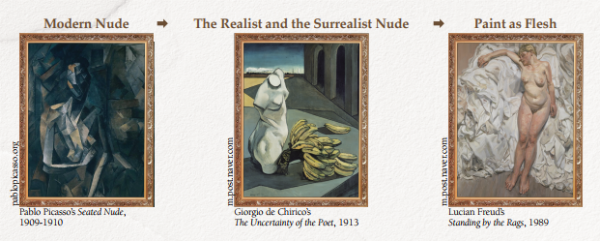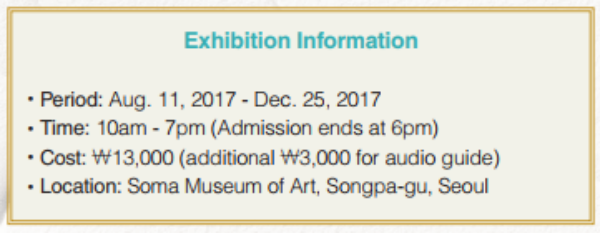The “Nude: Masterpieces from Tate” exhibition exhibits artworks from Tate Gallery. Tate Gallery is a national gallery of England which houses some of the world’s best masterpieces of famous artists like Pablo Picasso, Auguste Renoir, and Francis Bacon. Among Tate’s masterpieces, 122 artworks from 66 artists that are related with the theme “Nude” recently came to Korea. Through this exhibition, people can see how nudes have changed over 200 years and look at beautiful artworks. The exhibition is composed of eight themes: the historical nude, the private nude, the modern nude, the realist and the surrealist nude, paint as flesh, the erotic nude, body politics, and the fragile body. Therefore, the Sungkyun Times (SKT) introduces Kingos to basic information regarding the exhibition and how nude paintings have changed.
Whose Nudes Did the Masters of Tate Draw?

In the exhibition “Nude: Masterpieces from Tate,” people can see various artworks along with the changes in naked bodies over time. In the early 18th to 19th century, nude paintings were considered as the essence of academy education in Europe. Artists in this period usually drew nudes of ancient mythological characters as well as characters from the Bible. In 1898, for example, Herbert James Draper painted The Lament for Icarus. The painting depicts a dead Icarus and three lamenting nymphs around him. Icarus is a character from Greek mythology who flew too close to the sun with his wings, which were made up of wooden frames and wax. As he got closer to the sun, the wax melted and Icarus fell to his death. Likewise, nudes of ancient mythological characters were the main subjects of artworks in this period. In the early 20th century, artists started to deviate from painting mythical characters’ nude. Instead, they started to observe bodies of real women and painted them nude instead. The main subjects of the nudes in this period, were bathing or reclining women. It is probably because during this period, the majority of artists were male and these artists started to deem the curves of a woman’s body as artistic beauty. In 1936, for instance, the famous artist Henri Matisse drew a reclining woman in his painting, Draped Woman. The flower patterns of the woman’s clothes and the exotic plant in the back implies that the draped woman is an odalisque, a female slave or a concubine in a harem. In other words, instead of painting mythical characters, Henri Matisse had been observing a real odalisque in order to draw nude paintings.
In the 20th century, the eroticism of nude art appeared, which is also known as the sexual appetite of the nude. Artists in this period started to depict two or more people in their artworks, usually a male and a female. Auguste Rodin, for example, depicted the passionate kiss between a man and a woman through his sculpture The Kiss. Actually, the original work of The Kiss has never been exhibited in an Asian country before. “Nude: Masterpieces from Tate” in Korea, therefore, is the first time that The Kiss has been exhibited in Asia. In modern times, the process of raising objections towards the unfair relationships of power have occurred actively. During this process, depicting white women in nude paintings has been opposed by many feminine artists. As a result, some artists started to paint nude males in the same traditional poses as nude women. Family Jules: NNN (No Naked Niggahs) painted by Barkley L. Hendricks in 1974, for instance, shows the nude depiction of a black male with the traditional pose of a nude woman. Moreover, the title NNN also shows the opposition to unequal relationships of power effectively.
Lastly, nowadays, the tendency of expressing humans as weak and finite creatures through nudes is spreading. Cindy Sherman, for example, illustrated the aging of the human body through nudes in her artwork Pink Robes. As can be seen in the examples explained above, the subjects of nude artworks have been changing over time.
How Did the Masters of Tate Draw Nudes?

Over time, the methods of expressing nude have also changed. During the modernism period, which is between the 1890s and 1920s, the nude has been established as one genre. Artists in this period put more significance on drawing the form of the body instead of drawing the body as realistic as possible. For example, when people look at Pablo Picasso’s Seated Nude, which was painted in 1910, they will easily recognize that the painting does not look like a real person’s nude. Instead, it is minimized into geometric factors. From the 1920s to 1940s, realism and surrealism, the tendency to draw nudes as realistic as possible, and to draw nudes creatively from using factors of unconsciousness, respectively, were compatible. For instance, The Uncertainty of the Poet by Giorgio de Chirico placed objects such as bananas, a torso, a building, and a train together without any meaning. These four subjects do not have any common factors, being an important characteristic of surrealist artwork. In the 1950s, realism divided sophisticatedly into various factors and people started to focus on using different and unique methods to make their art look more real. Lucian Freud, for instance, used abundant amounts of paints in order to make the painting look more realistic. These tendencies are all mixed up these days, influencing artists living in the 21st century.
There are many other new and beautiful artworks related with nudes in this exhibition. Therefore, it will be a refreshing and exciting opportunity for Kingos to visit this exhibition with friends or family.

